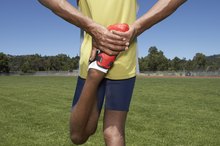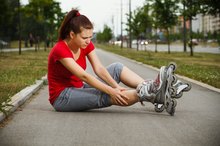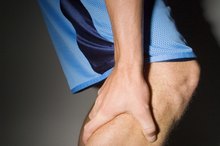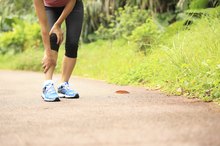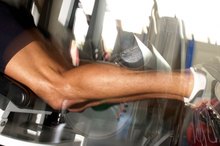What Causes Leg Cramps After Exercise?
Leg cramps are a common experience for many athletes, but they don't have to be part of your exercise regimen.
In many cases, taking some simple preventive measures can eliminate cramps altogether. In the event they persist, however, you should consult your doctor to rule out an underlying medical disorder.
Features of Cramps
Cramps in the leg, commonly referred to as a charley horse, occur when one of the muscles or a group of muscles contracts forcibly and doesn't stop contracting. The result can be a brief, mildly annoying sensation, or a sharp pain if the cramp is more severe.
Severe cramps can cause the muscle to contract so strongly that it knots up and forms a lump under the skin. Cramps may come and go for several minutes before disappearing.
Anyone can get a leg cramp, but beginning exercisers and more seasoned endurance athletes are among those commonly afflicted. The exact reason leg cramps occur after exercise is not known, but there are some contributing factors.
- Cramps in the leg, commonly referred to as a charley horse, occur when one of the muscles or a group of muscles contracts forcibly and doesn't stop contracting.
- Anyone can get a leg cramp, but beginning exercisers and more seasoned endurance athletes are among those commonly afflicted.
Dehydration and Electrolyte Imbalances
What Are the Causes of Leg & Foot Cramps?
Learn More
If your muscles lack sufficient water, it can lead to cramping. Dehydration can also lead to an imbalance in the levels of electrolytes, such as potassium, sodium and magnesium, which can also cause leg cramps. If you aren't getting enough electrolytes in your diet, it can have the same effect.
Drinking water throughout the day can help you avoid dehydration. Drink 1 to 3 cups of water right before exercise and take small sips during activity.
After activity, drink water or a sports drink enhanced with electrolytes rehydrate yourself fully.
Drink more water if you exercise in hot temperatures.
Eat a nutrient-rich diet that contains plenty of electrolytes. Taking a multivitamin can also help.
- If your muscles lack sufficient water, it can lead to cramping.
- Drinking water throughout the day can help you avoid dehydration.
Fatigue and Muscle Flexibility
If you are not in shape, your muscles won't contract as efficiently, and you may experience leg cramps. Failure to warm up and stretch before exercise can have a similar effect. To remedy the problem, focus on building up your endurance slowly and gradually. Avoid overexertion and pace yourself during exercise. Perform a warmup before exercising and gently stretch your leg muscles. Cooling down after exercise and continuing to stretch the muscle can also help.
- If you are not in shape, your muscles won't contract as efficiently, and you may experience leg cramps.
- Cooling down after exercise and continuing to stretch the muscle can also help.
Other Causes
Cramping During Crunches
Learn More
In some cases, exercise is not the cause of your leg cramps, although it may exacerbate the problem.
Certain prescription medications can cause leg cramps as a side effect, primarily because they deplete the electrolytes in your body. Talk to your doctor if you suspect a medication may be causing cramping. Muscle cramps are also associated with medical disorders, including disorders of the nerves, kidneys, thyroid and hormones. Diabetes, hypoglycemia and anemia can also cause muscle cramps. Consult a doctor if you have muscle cramping outside of exercise or if your leg cramps persist despite your taking steps to change your eating, drinking and exercise habits.
- In some cases, exercise is not the cause of your leg cramps, although it may exacerbate the problem.
- Certain prescription medications can cause leg cramps as a side effect, primarily because they deplete the electrolytes in your body.
Treatment
Leg cramps don't usually require medical treatment and most will go away on their own. If a cramp lasts longer than a few seconds, you can help get rid of it by grabbing the affected leg muscle while stretching it. If the cramp does not go away completely or if the muscle is still tight, apply heat. Tender or sore muscles should be treated with cold. Seek medical attention if the cramps don't go away after self-care measures.
- Leg cramps don't usually require medical treatment and most will go away on their own.
- If a cramp lasts longer than a few seconds, you can help get rid of it by grabbing the affected leg muscle while stretching it.
Related Articles
References
- MedlinePlus.com: Charley Horse
- American Academy of Orthaepedic Surgeons: Muscle Cramp
- Young G. Leg cramps. BMJ Clin Evid. 2015;2015
- Jahic D, Begic E. Exercise-associated muscle cramp-doubts about the cause. Mater Sociomed. 2018;30(1):67-69. doi:10.5455/msm.2018.30.67-69
- Waters TR, Dick RB. Evidence of health risks associated with prolonged standing at work and intervention effectiveness. Rehabil Nurs. 2015;40(3):148-65. doi:10.1002/rnj.166
- Skogar O, Lokk J. Pain management in patients with Parkinson's disease: challenges and solutions. J Multidiscip Healthc. 2016;9:469-479. doi:10.2147/JMDH.S105857
- Hallegraeff J, De greef M, Krijnen W, Van der schans C. Criteria in diagnosing nocturnal leg cramps: a systematic review. BMC Fam Pract. 2017;18(1):29. doi: 10.1186/s12875-017-0600-x
- Mcdermott MM. Lower extremity manifestations of peripheral artery disease: the pathophysiologic and functional implications of leg ischemia. Circ Res. 2015;116(9):1540-50. doi:10.1161/CIRCRESAHA.114.303517
- Blyton F, Chuter V, Walter KE, Burns J. Non-drug Therapies For Lower Limb Muscle Cramps. Cochrane Database Syst Rev 2012; 1:CD008496.
- Grandner MA, Winkelman JW. Nocturnal leg cramps: Prevalence And Associations With Demographics, Sleep Disturbance Symptoms, Medical Conditions, And Cardiometabolic Risk Factors. PLoS One 2017; 12:e0178465.
- Allen RE, Kirby KA. Nocturnal Leg Cramps. Am Fam Physician 2012; 86:350
- American Academy of Sleep Medicine. Sleep Related Leg Cramps. In: International Classification of Sleep Disorders, 3rd ed., American Academy of Sleep Medicine, Darien, IL 2014. p.299-303.
- Maquirriain J, Merello M. The Athlete with Muscular Cramps: Clinical Approach. J Am Acad Orthop Surg 2007; 15:425.
Writer Bio
Solomon Branch specializes in nutrition, health, acupuncture, herbal medicine and integrative medicine. He has a B.A. in English from George Mason University, as well as a master's degree in traditional Chinese medicine.
